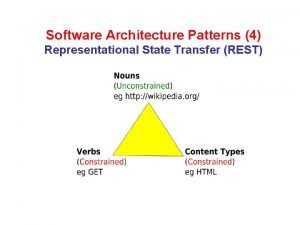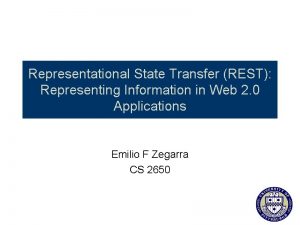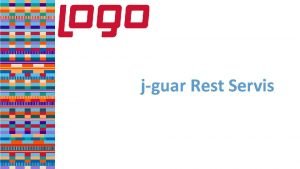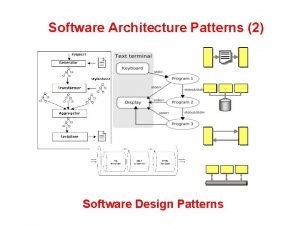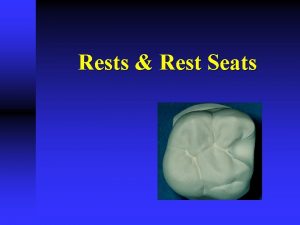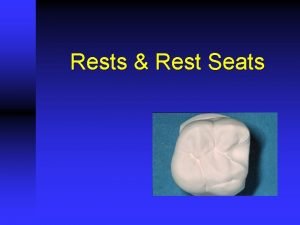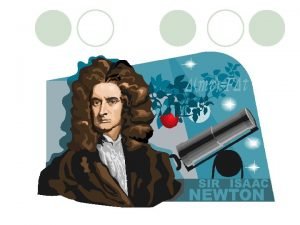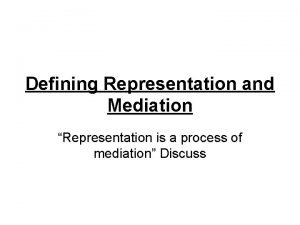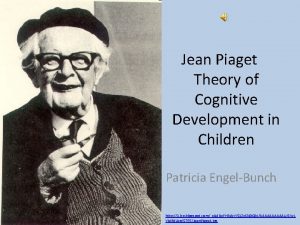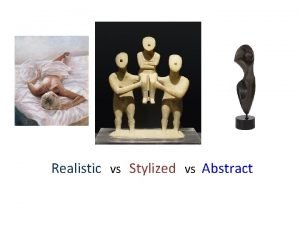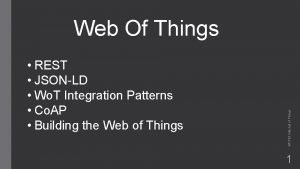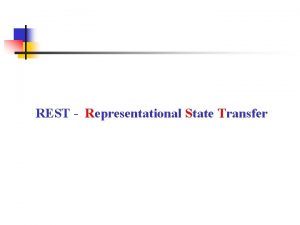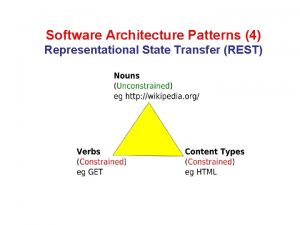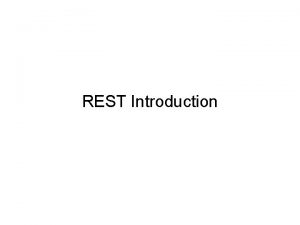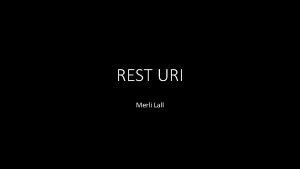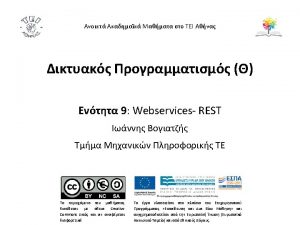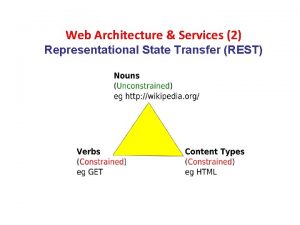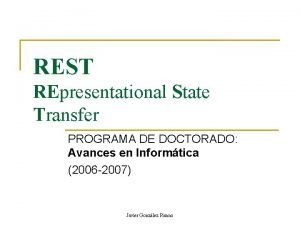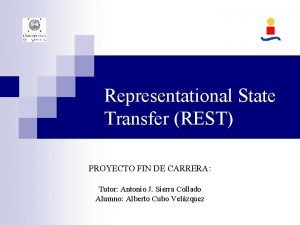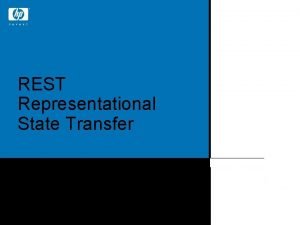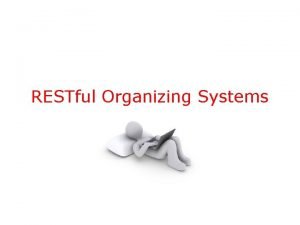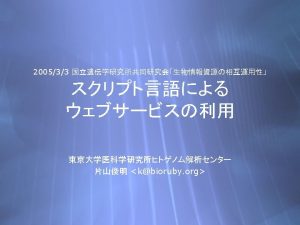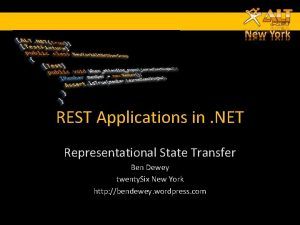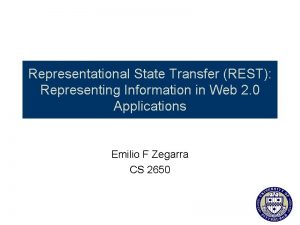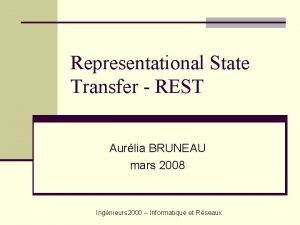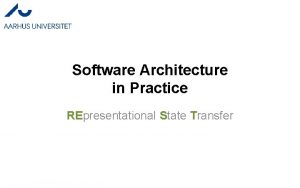Software Architecture Patterns 4 Representational State Transfer REST




















- Slides: 20

Software Architecture Patterns (4) Representational State Transfer (REST)

What is REST? Representational State Transfer (REST) is an architectural style for building distributed systems. The WWW is an example for such a system. REST-style applications can be built using a wide variety of technologies. REST's main principles are that of resource-oriented states and functionalities, the idea of a unique way of identifying resources, and the idea of how operations on these resources are defined in terms of a single protocol for interacting with resources. REST-oriented system design leads to systems which are open, scalable, extensible, and easy to understand.

The Web as a System • The Web is one distributed hypermedia system • the main architectural components are URIs, HTTP, and HTML • all other Web technologies are built on that foundation • if they are not, they are very likely not well-designed Web technologies • The Web is amazingly open, scalable, extensible, and easy to understand • openness allows new technologies to be introduced • scalability ensures that the system does not contain bottlenecks • extensibility allows the Web to evolve without any redesign of existing parts • simplicity makes sure that the system survives and evolves

Web Servers • Web Servers provide a service - Web pages can be retrieved (by a client) - Web pages can be uploaded to the server - clients can submit (HTTP POST) data to a resource - Web pages can be removed from the server - the original design of the Web was a writable Web • For complex interactions, more operations are required - Web Distributed Authoring and Versioning (Web. DAV) - defines additional HTTP methods - the basic HTTP methods may not always be sufficient - if required, additional methods on resources can be defined - if possible, these should be reusable for many resource types

Web Technologies • Web technologies must work in a RESTful way • resources are identified by URIs and can be navigated • resources have a state and can be accessed using HTTP • state transitions are modeled as resource accesses • If applications work different, they are not Web technologies • they (or their data) may be accessible over the Web • they may be integrated into Web browsers • but they violate basic architectural principles of the Web • Plug-ins other than single-presentation resources • PDFs break a lot of browser navigation features • Java applets are inaccessible from the outside

REST principles • Resources are defined by URIs • Resources are manipulated through their representations • Messages are self-descriptive and stateless • There can be multiple representations for a resource • Application state is driven by resource manipulations

Resources • Resources are defined by URIs • resources can never be accessed or manipulated directly • REST works with resource representations • Resources are all the things we want to work with • if you cannot name something, you cannot do anything with it • a popular resource type on the Web are documents • documents usually are a structured collection of information • Documents are abstract concepts of descriptive resources • they may be used in different contexts (e. g. , formats) • different applications may be interested in different representations • the underlying resource is always the same

State • State is represented as part of the content being transferred • server interruptions do not create problems for the client • it is possible to switch between servers for different interactions • clients can simply store the representation to save the state • State transfer makes the system scalable • data transfer is not state-specific (no stateful connection handling) • state is transferred between client and server • Loose coupling not only applies to API vs. document • by transferring state, clients and server are decoupled state-wise • this makes the handling of interactions much easier

Establishing a Common Model • Distributed systems must be based on a shared model • traditional systems must agree on a common API • SOA systems must agree on a number of messages (WSDL) • REST systems structure agreement into three areas • REST is built around the idea of simplifying agreement • nouns are required to name the resources that can be talked about • verbs are the operations that can be applied to named resources • content types define which information representations are available

REST Triangle

Nouns • Nouns are the names of resources • in most designs, these names will be URIs • URI design is a very important part of a REST-based system design • Everything of interest should be named • by supporting well-designed names, applications can talk about named things • new operations and representations can be introduced • Separating nouns from verbs and representations improves extensibility • applications might still work with resources without being able to process them • introducing new operations on the Web does not break the Web • introducing new content types on the Web does not break the Web

Verbs • Operations which can be applied to resources • The core idea of REST is to use universal verbs only - universal verbs can be applied to all nouns • For most applications, HTTP's basic methods are sufficient - GET: Fetching a resource (there must be no side-effects) - PUT: Transfers a resource to a server (overwriting if there already is one) - POST: Adds to an existing resource on the server - DELETE: Discards a resource (its name cannot be used anymore) • Corresponding to the most popular basic database operations CRUD: Create, Read, Update, Delete

Content Types • Representations should be machine-processable • they don't have to, they may be opaque to applications • in many cases, machine-processable representations are advantageous • Resources are abstractions, REST passes representations around • resources can have various representations (i. e. , content types) • clients can request content types they are interested in • Adding or changing content types does not change the system architecture • different clients and servers support different content types • Content Negotiation allows content types to be negotiated dynamically

REST Claims • Caching improves response time and reduces server load • Less communication state enables easier load balancing between servers • Less specialized software because the underlying technologies are simple • Identification is done using standard mechanisms, no additional names necessary

REST Technologies • REST is not tied to a particular set of technologies • URIs are the most common choice for nouns • HTTP methods are the most common choice for verbs • XML is the most common choice for content types • Choosing other technologies should have a very good reason • building a REST system should make it open and accessible • technology choices are as important as architectural choices

URIs • REST requires a lot of URI design • instead of being generated as a side-effect, they are the core of the system • Designing URIs and starting from them is a new way of thinking • URIs are much more powerful than just being an address of a Web page • URIs are names for concepts • concepts are never transmitted, only their representation • having to focus on concepts rather than representations is helpful

HTTP • HTTP is the most successful RESTful protocol - HTTP's author Roy Fielding coined the term REST in his Ph. D. thesis • HTTP should be regarded as an application-level protocol - Web Service technologies use HTTP as a transport protocol - HTTP has much more to offer than a firewall-penetrating pipe • Web infrastructure is built around proper HTTP usage - caching is built into HTTP and caches optimize the Web transparently - authentication can be done using HTTP's authentication methods - secure data transfer can be done using HTTP over SSL (HTTPS)

XML • URI-identified resources are abstract concepts • for machine-based processing, XML is a good representation • for human-oriented interactions, HTML probably is a better choice • Connections to other resources must be done by URI • XML does not make built-in assumptions about identifiers • but it does support URIs, for example with XInclude and XML Base • RESTful applications are about navigating a Web of URIidentified resources

Better Services • REST is an architectural style • URI/HTTP/HTML/XML may be replaced • the general principle of resource-based interaction remains valid • RESTful system designs can create better systems • a little bit more design effort in the beginning • a lot less headaches later • SOA often are not really RESTful • SOA often focuses on operations • REST focuses on resources • RESTful design is a good starting point for OO implementations

Original Content: Copyright © 2006 Erik Wilde, UC Berkeley http: //dret. net/lectures/services-fall 06/rest
 Representational state transfer
Representational state transfer Representational state transfer
Representational state transfer Logo rest servis
Logo rest servis Design patterns in architecture
Design patterns in architecture Lingual rest
Lingual rest Indirect retainer in class 1
Indirect retainer in class 1 Rest rest perturbed spirit
Rest rest perturbed spirit Incisal rest
Incisal rest An object at rest stays at rest
An object at rest stays at rest Representational mediation process
Representational mediation process Representational hemisphere
Representational hemisphere Concrete operational stage
Concrete operational stage Concrete representational abstract examples
Concrete representational abstract examples Allan houser reverie
Allan houser reverie Representational adequacy
Representational adequacy Stylized naturalism
Stylized naturalism The architecture business cycle
The architecture business cycle Call and return architecture in software architecture
Call and return architecture in software architecture Rest integration patterns
Rest integration patterns Software implementation of state graph
Software implementation of state graph Dating patterns since the 1960s are
Dating patterns since the 1960s are
